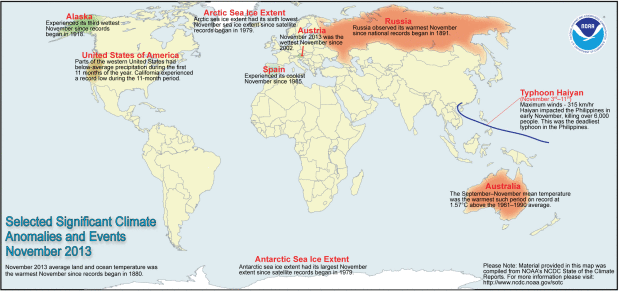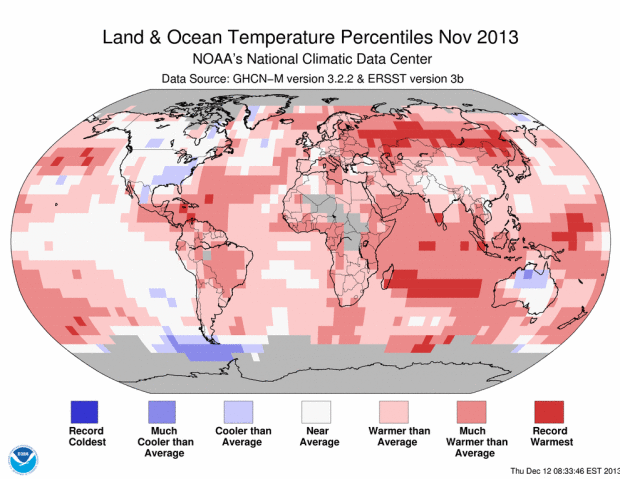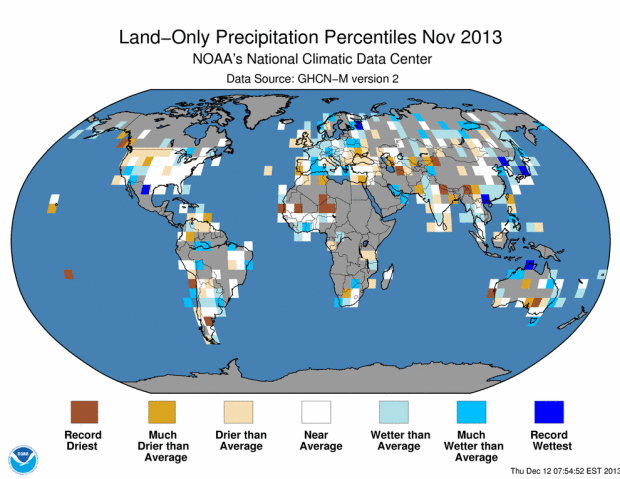
November, 2013 was the warmest November on record for both air temperatures as well as sea temperatures since records began in 1880. We’ll let NOAA display the facts supporting all this below.
It very well may be true the sports of skiing and snowboarding have a limited future as global temperatures continue to rise.
Learn much much more about this topic from NOAA here:
Global Analysis – November 2013
 NOAA’s Global Highlights
NOAA’s Global Highlights
- The combined average temperature over global land and ocean surfaces for November 2013 was record highest for the 134-year period of record, at 0.78°C (1.40°F) above the 20th century average of 12.9°C (55.2°F).
- The global land surface temperature was 1.43°C (2.57°F) above the 20th century average of 5.9°C (42.6°F), the second highest for November on record, behind 2010. For the global oceans, the November average sea surface temperature was 0.54°C (0.97°F) above the 20th century average of 15.8°C (60.4°F), tying with 2009 as the third highest for November.
- The combined global land and ocean average surface temperature for the September–November period was 0.68°C (1.22°F) above the 20th century average of 14.0°C (57.1°F), the second warmest such period on record, behind only 2005.
- The September–November worldwide land surface temperature was 1.08°C (1.94°F) above the 20th century average, the third warmest such period on record. The global ocean surface temperature for the same period was 0.52°C (0.94°F) above the 20th century average, tying with 2009 and 2012 as the fourth warmest September–November on record.
- The combined global land and ocean average surface temperature for the year-to-date (January–November) was 0.62°C (1.12°F) above the 20th century average of 14.0°C (57.2°F), tying with 2002 as the fourth warmest such period on record.
NOAA’s Select National Temperature Information:
- According to Roshydromet, Russia observed its warmest November since national records began in 1891. Some areas of the Urals, Siberia, south of the Far East region, and on the Arctic islands in the Kara Sea had temperatures that were more than 8°C (14°F) higher than the monthly average.
- The average November temperature across the United Kingdom was 0.7°C (1.3°F) below the 1981–2010 average.
- Spain was 0.5°C (0.9°F) below the 1971–2000 average temperature for the month, although the first half was 2°–3°C (4°–5°F) above average while the second half was 3°–4°C (5°–7°F) below average, the coolest such period since 1985.
- The average November temperature across Norway was 1.5°C (2.7°F) higher than the 1981–2010 average, with some regions 2°–3°C (4°–5°F) above average.
- Record warmth continued in Australia towards the latter part of 2013, as the country observed its highest average and maximum spring (September–November) temperatures in its 104-year period of record at 1.57°C (2.83°F) and 2.07°C (3.73°F) above the 1961–1990 average, respectively. The nationally-averaged minimum spring temperature was fourth highest on record, at 1.07°C (1.93°F) above normal.
- The average temperature was higher than the 1971–2000 average across all of Hungary for November, with departures up to +3°C (+5°F) in the western half and more than +4°C (+7°F) in the far east.
- November temperatures were 3.9°–5.2°C (7.0°–9.4°F) above average across the Republic of Moldova. According to Serviciul Hidrometeorologic de Stat, this type of event in the north occurs every 20–30 years and every 10–15 years in the south.
- According to the Fiji Meteorological Service, most regions of the country were considerably warmer than the 1971–2000 average, with maximum and minimum temperature anomalies exceeding 1°C (1.8°F) at more than half of the 21 official monitoring stations. New November monthly warm minimum temperature records were set at four stations, with periods of records ranging from 35 to 71 years.
- Croatia was “very warm” (91st– 98th percentile) in part of the north and across the south and “warm” across much of the remainder of the country, according to Državni hidrometeorološki zavod. No regions were considered “cold”.

